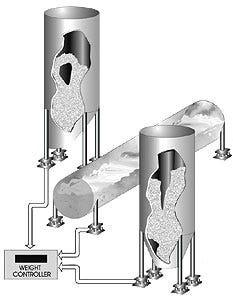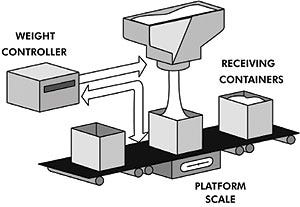Typical Process-Weighing Applications
December 5, 2006
|
Figure 1: Level by weight |
Process weighing relates to the weighing of a powder material as part of a production process. The technology includes continually monitoring a material in a silo, discharging material by weight or rate, or even weighing products on the move. This article gives an overview of most of the typical process weighing applications that are used in all sorts of industries: level or inventory measuring and controlling, bag or drum filling and dispensing, batch weighing, simultaneous blending of multiple ingredients, and measuring and controlling mass flow.
Measuring and Controlling Level or Inventory
Level or inventory weighing applications range from being able to tell if your storage vessel is 20 or 30% full to knowing precisely how much material is in the vessel. It may also involve automatic control of storage-vessel refill. The weighing system must be able to ignore plant and process mechanical noise while having enough resolution to indicate weight with the desired precision. These applications can usually be satisfied by simply transmitting weight information to a PLC PC or DCS and do not involve time-critical weight cutoffs. A local display of the level is often desirable.
Measuring level or inventory by weight is the most accurate technology. Ingredients that foam or settle unevenly with changes in density, materials that have stratified layers with different dielectric constants, and poor reflectivity or vessel shape do not affect weight. Weight is weight, regardless of the percentage of solids, bridging, or rat holing. It is not affected by ingredients that are conductive or sound absorbing. Because weighing is a noncontact method of measuring level, it does not cause contamination. You never have to worry about a caustic ingredient damaging the weighing system.
To weigh a storage vessel, it must be supported entirely by load cells. For example, a silo would have a load-point assembly—a load cell and mounting hardware—under each leg (see Figure 1). On a skirted silo, a frame is constructed under it to transfer the weight to three or four load points. Horizontal tanks sitting on saddles are retrofitted with load points to accommodate vessel expansion and contraction caused by changes in temperature.
Filling, Dispensing, and Batch Weighing
While filling, dispensing, and batch weighing are different operations, their accuracy and speed requirements are the same. The weighing system must
• Accurately and reputably detect changes in weight in order to provide accurate weight cutoffs.
• Monitor the weight often enough (typically a minimum of 20 times per second) to detect small changes.
• Ignore plant and process mechanical noise during a filling or dispensing cycle.
• Compensate for system delays and in-flight material.
• Provide a consistent system response (variable response times cause unequal amounts of material to be delivered).
• Monitor for slow or blocked feed rates that indicate malfunctioning gates or ingredient bridging.
Local display and manual control of the weighing functions are also desirable in most cases.
Filling. Also called gain-in-weight, filling is the adding of weight to a scale. Filling systems use load points or platform scales to weigh material being placed into a container. Examples include the sequential filling of empty containers manually put on a scale by a conveyor (see Figure 2) or filling a stationary weigh vessel on load cells. The weight of the container is tared (zeroed out) so that only the net weight of the material in the container is displayed. Multiple speeds can be used to increase fill accuracy. The controller allows the gate to be fully open for fast fill or partially open to dribble in the exact amount.
|
Figure 2: Filling application |
Dispensing. Also called loss-in-weight, dispensing is the removing of weight from a scale. A dispensing system uses load points or platform scales to weigh the material being sent or dispensed into a container. Examples include the sequential filling of empty containers manually put under the scale by a conveyor or filling a stationary vessel or process equipment. The weight of the dispensing vessel is tared and the net weight of the material dispensed to the container is displayed. As in filling applications, multiple speeds can be utilized to increase the accuracy of the amount of material dispensed.
Intermediate Bulk Container (IBC) Dispensing. The dispensing of an IBC, either a soft-sided bag or a hard-sided container (tote), from a scale into another container or piece of process equipment is associated with loss-of-weight systems. IBCs are suspended by load points that weigh the material dispensed from the IBCs into receiving containers below. Controllers open and close the discharge gates while weighing the amount of material lost. IBCs are often exchanged in the middle of the filling process when one is emptied. A controller must retain the amount dispensed from the first IBC in its memory so that it knows how much material is required from the second IBC to achieve the desired weight. By replacing the empty IBC with a full one, the scale sees a gain in weight. The controls remember how much is required and only dispense material to meet the setpoint amount.
Batching and Blending. Batching and blending involves weighing one or more ingredients of a formula or recipe in a single vessel and then discharging the blend to downstream processes. The vessel can be a simple hopper or tank and can contain a built-in mixer, an agitator, or heating and cooling device. Ingredients are conveyed, extruded, vibrated, pumped, hand delivered, or gravity-fed to gates or valves above the vessel. Single-ingredient batching consists of repeatedly weighing and discharging the same ingredient. In multiple-ingredient batching, two or more ingredients are weighed for a specific formula or recipe. Ingredients can range from granular, powder bulk, and dry materials to slurries or liquids. Some ingredients are so small that they cannot be accurately weighed in the same vessel as a major ingredient. Such minor ingredients are either volumetric or are preweighed and then automatically added to the batch. Alternatively, the formula sequence goes to “hold” to enable it to be added by hand.
The accuracy of the weight of batched materials is increased using multiple-speed capabilities. A fast or bulk speed, where valves or gates are wide open to allow maximum flow, is used for most process cycles. Slow and/or dribble speeds are used for short durations at the end of a sequence when the valves or gates are nearly closed. Slow or dribble speeds allow for greater accuracy, enabling manufacturers to achieve the final desired weight without under- or overshooting. As with a gas station pump, most of the material is dispensed quickly, while the final portion is dribbled in to allow the batch controller to accurately cut off the flow. In some instances, different feed algorithms have been designed to eliminate the need for multiple speeds.
Batching is classified as either sequential (gain-in-weight) or simultaneous (loss-of-weight). Either method can incorporate both gain-in-weight and loss-of-weight in the same process.
Sequential batch control is a gain-in-weight application in which multiple ingredients are added one at a time into a single weigh vessel mounted on or suspended by one or more load points. A controller opens and closes the individual material gates or valves while weighing the added ingredients. The batch is tared in the “net” mode and the next ingredient is selected. The controller also opens or closes the discharge gate or valve of the weigh vessel for total or incremental discharge of the batch contents.
Simultaneous batch control is a loss-of-weight application in which multiple ingredients are added to a single vessel at the same time. Ingredients are dispensed from weigh vessels and/or feeders that are mounted on or suspended by one or more load points. Controllers open and close these dispensing gates or valves and can also control the rate of material flow through feeders on platform scales. These controllers open and close the batch-vessel discharge gate or valve for total
or incremental discharge of the batch.
The initial cost of setting up a simultaneous batch system is significantly higher than that of a sequential one, but the batch/blend process is faster. Faster batching and blending means that more products can be made in less time, increasing plant process throughput.
Measuring and Controlling Mass Flow. Rate-by-weight measures the amount of material that enters into or is dispensed from a vessel over a given period of time. Solids, liquids, or gases can be monitored or controlled precisely using screw- or auger-based feeders, vibratory-feeder conveyors, or belt feeders along with variable seep pumps and valves.
Material is moved in a process that is either volumetric or gravimetric. In volumetric mode, a known volume of material is moved per unit of time at a given speed. In gravimetric mode, the variable setpoint of weight is divided by a variable of time (e.g., pounds per minute) to determine a mass-flow rate.
In gravimetric mode, material is moved at a controlled rate around a setpoint. This mass flow can be used in a continuous or batch process. In a continuous process, material constantly flows at a controlled rate. In a batch process, material flows at a controlled rate and is totalized until a predetermined setpoint amount is reached. This approach is used when controlled accuracy is required, when the bulk density of the material varies, or when a record of the material’s weight is required. Gravimetric systems are accurate and usually more expensive than volumetric systems.
In a gravimetric loss-in-weight system, a bin or hopper—along with a feeder and its material—is mounted to load cells or on a scale. This scale system senses change in weight as material exits the bin, and it automatically calculates a flow-rate signal that speeds up or slows down the feeder based on a setpoint.
Monitoring the flow rate determines a constant flow rate (a material on a conveyor belt, a section of which has a scale under it) or varying or “wild” material flows that can be measured but not controlled. For example, an extruder (or feeder) on load cells, in which material constantly enters and exits, requires flow monitoring. The weight in the extruder (determined by taring the extruder’s weight) can be read at any time to calculate a constant weight. Upper and lower limit setpoints can be set to notify users when material blockages affect material entering or leaving the extruder.
Ted Kopczynski is process weighing product marketing manager at Hardy Instruments, San Diego, CA. He can be reached at 858-292-2710, ext. 1210, or [email protected].
About the Author(s)
You May Also Like






